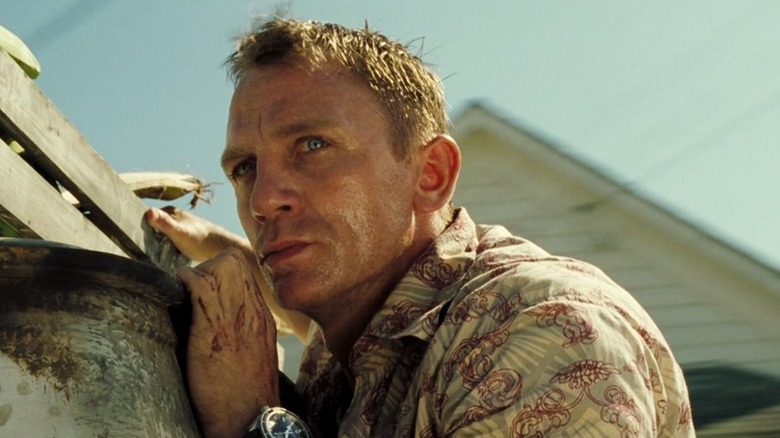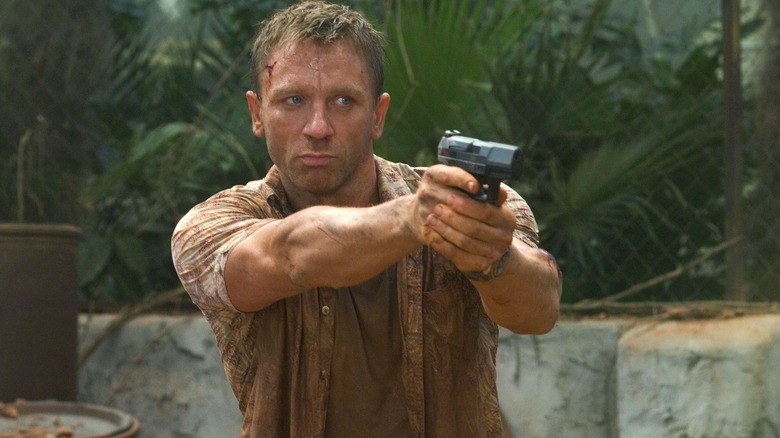The Parkour Chase In Casino Royale Is The Best Action Scene Ever
(Welcome to Best Action Scene Ever, a column dedicated to breaking down the best, most effective action sequences throughout the genre. In this edition, we look back at the birth of a new Bond in the opening moments of 2006's "Casino Royale.")
It may be hard for some to remember now, especially in light of the downright schmaltzy ending the character received in "No Time To Die," but Daniel Craig's James Bond wasn't always given the red carpet treatment as if he were the homecoming hero for the ages. In the early 2000s, the rough-cut blonde was largely an unproven talent who was mostly familiar to audiences for a bit role in Steven Spielberg's "Munich," his leading turn in Matthew Vaughn's "Layer Cake," and an appearance in 2001's "Lara Croft: Tomb Raider." Without the benefit of an established history to his name, diehards and general audiences alike all but revolted at the idea of such an unsophisticated piece of casting for the most suave of superspies.
Fast forward almost a decade and a half later, and it's clear who came out on top in the long run. Craig went on to solidify his run as James Bond as one of the most crowd-pleasing takes on the character ever. But what about the extended action sequence in "Casino Royale" that first gave us an idea of just how different his take on the famous Ian Fleming character would be? In the span of 10 parkour-infused minutes, director Martin Campbell managed to completely rewrite the definition of Bond forever. Given the stakes involved, there's a compelling argument to be made that the character has never shined brighter.
The scene
We've seen Bond's first kill. We've been introduced to the movie's villains. Now, it's time to see Craig's James Bond in his natural element: out in the field and on a dangerous job that only he could ever pull off. Fitting for the much more grounded premise of the film, our first real look at Bond in action involves following a lowly bomb maker in Madagascar. Portrayed by free-running expert Sébastien Foucan, the minor antagonist Mollaka is nonetheless treated with deadly seriousness. When Bond's incompetent field operative blows their cover, Mollaka leads Bond on a cat and mouse chase through some of the most dynamic geography in all of "Casino Royale."
Although both combatants have easy access to weapons, neither engages in a shootout – in a refreshing twist, they both rely on much more interesting skills like speed, guile, and resourcefulness to come out on top. Their chase takes them from a gambling snake pit to a construction zone, providing all sorts of natural (and fun!) obstacles in their path. Mollaka deftly navigates these challenges by jumping through hollowed-out shells of abandoned vehicles with ease or scaling fences without breaking a stride. For his part, Bond's "blunt instrument" of an agent simply uses brute force to keep pace with his target, culminating in the sight gag of him commandeering a bulldozer and smashing it into the skyscraper currently under construction.
What follows is an increasingly thrilling and more complicated set piece that soon forces viewers to wonder whether this one bad guy could possibly be worth all this trouble. Luckily, that's exactly what this masterpiece of a movie is trying to communicate.
Why it works
By now, you've certainly heard that the best scenes in the genre are the ones that convey character through action. You'd be hard-pressed to find one that measures up to how efficiently the parkour sequence in "Casino Royale" manages to pull this off. As our first major introduction to how this version of Bond carries himself, audiences couldn't possibly have asked for better than this. The stunts, the choreography, the camerawork, and the propulsive score by David Arnold (with a crucial assist by Chris Cornell's theme song "You Know My Name," which is directly incorporated into the original score) all work together to create a short film of sorts that stands out as arguably the purest distillation of Craig's take on the character.
The sequence reaches new heights (literally!) when both end up climbing the skeleton of the building, punctuated by explosions, mass mayhem, and a particularly daring move that sees Bond and Mollaka suspended hundreds of feet in the air for a dizzying and brutal hand-to-hand fight. At every turn, however, the bomb maker continues to nimbly escape while his lumbering pursuer barely manages to keep on his heels. But what Craig's Bond lacks in finesse, he makes up for in sheer determination and bravado. As much as fans will remember the laugh-out-loud moment where Mollaka draws his weapon, realizes he's run out of ammo, and throws his gun at Bond only to have him catch it and throw it right back at him, the most quintessential example of character-building in the early going comes when Foucan executes a flawless jump through a tiny opening in a wall ... while Craig bursts through the plaster as if he were the Kool-Aid man with a license to kill.
The key moment
As eluded to earlier, it doesn't take very long before this rather lengthy sequence soon forces audiences to question the lengths that Bond goes to in order to apprehend his target. With Mollaka having fled to seek refuge in the local embassy, Bond brazenly invades the complex (which, for those who may need to brush up on their international relations, is decidedly not great) and sets off a small army of soldiers who finally bring the firepower some fans may have missed to this point. Now having finally caught up to the bomb maker, the stakes change to somehow getting out of this predicament in one piece. Thanks to a combo of the sequence's nifty pacing and some subtly transformative editing by Stuart Baird, it all culminates in a standoff outside the embassy between Bond, his hostage, and every soldier with a gun currently trained on the British agent.
Faced with either certain death or surrender, Bond instead picks an unlikely third option: kill Mollaka, blow up the complex, and get out scot-free ... though with the film drawing our attention to the existence of some incriminating video evidence. In essence, the entire action scene is meant to establish Bond's reckless streak and complete disregard for the rules of engagement.
It's not exactly commonplace to introduce a new, highly-anticipated, yet controversial iteration of a beloved character by showing us how badly he screws up on one of his first jobs, but that's exactly the risky route that Campbell and writers Neal Purvis, Robert Wade, and Paul Haggis took with "Casino Royale." It quite obviously worked out, as fans were immediately taken in by the roughshod charm of this never-before-seen version of Bond. He may have ultimately received a hero's ending, but his unforgettable intro was anything but.

